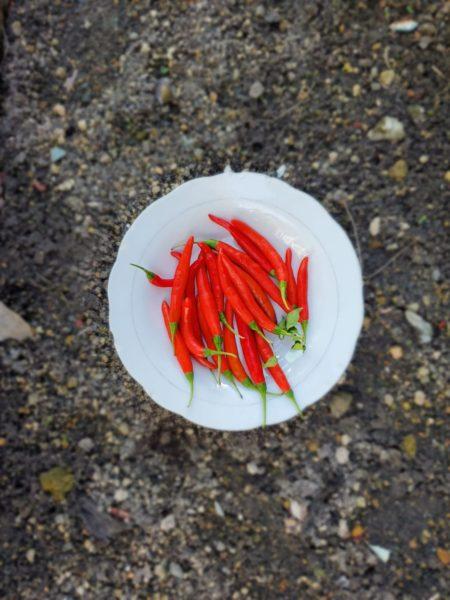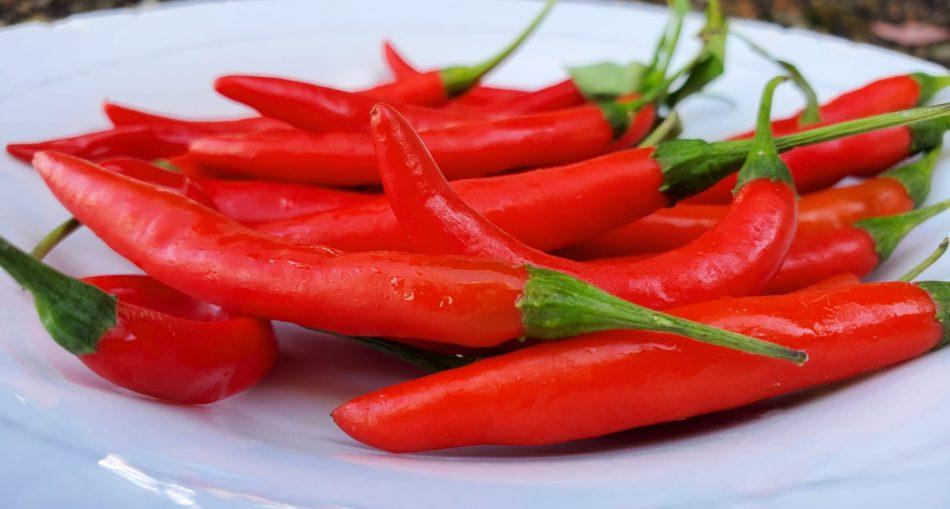Bird pepper has been kept in jars of vinegar in my home ever since I could remember. My mother would obsessively add them to ANY meal she would eat. The pepper instantly adds a spicy hit of flavour to any dish. African bird pepper as it is known as Pilli Pilli pepper is not only hot but also has various health benefits.
Fun Fact: Pilli Pilli is a name that simply translates to “pepper pepper” and derives from the Bantu Language, one of the most important language groups in Africa.
What Is Pilli Pilli Pepper Or African Bird Pepper?
It has grown wild in Africa for centuries until the Portuguese began to cultivate them within regions of Africa particularly Mozambique and its border regions with South Africa and then spread to other Portuguese domains. Now they have been under commercial cultivation for many years in Uganda, Malawi, and Zimbabwe. Other countries where it is cultivated include Papua New Guinea, China, Mexico, Chile, and India Many wild chiles have the word “bird” in their names, distinguishing among them can be difficult.
Most bird peppers are undomesticated varieties of four species: annuum, baccatum, chinense, and frutescens. The most familiar bird peppers are the Mexican chiltepin and the Texan chilipiquin. The African bird pepper is both wild and domesticated and is also known in English as African devil chile.
Fun Fact: The pepper is also known as Capsicum Annum
The bird pepper is quite hot with a Scoville scale ranging from 50,000 to 175,000 SHU making it one of the world’s hottest peppers. The Scoville scale is a measurement of the pungency (spiciness or “heat”) of chili peppers as recorded in Scoville Heat Units (SHU), based on the concentration of capsaicinoids among which capsaicin is the predominant component.
What Does Bird Pepper Look Like?

Photo of African Bird Peppers. Photo Credits: Nirmal Kawall
Depending on growing conditions, the plants range in height from one and a half to four feet tall and are usually very bushy. The leaves vary in length from 1 ½ to 3 inches and in width from ½ inch to 1 inch. The fruits generally measure between ½ and 1 inch long and taper to a blunt point. The immature pod color is green, mature color is bright red. The plants are perennial and sometimes produce for three years before they are plowed under. Growing African birdseye chiles is very labor-intensive and they require hand-picking. The pods are picked when they are bright red and 2 or fewer centimeters (3/4 inch) long. A single plant yields about 300 grams (2/3 pound) of fresh pods. Yields of about 1.8 metric tons per hectare are typical (a hectare is 2.47 acres).
Fun Fact: This pepper contains carotene molecules that have potent antioxidant elements. African Bird Pepper, and more specifically Cayenne, has been successfully used to treat arthritis, psoriasis, cluster headaches, and amputation pain as well as lower the rate of cardiovascular disease. (This will be discussed in more detail further down.)
How To Store Bird Pepper
It’s feasible to store in a sealed container away from heat and moisture; hence, refrigerate. A recommendation is to handle it with care, so it’s best to always wash your hands after handling the pepper. Always avoid your eyes and nose while handling the pepper as well. They can also be stored in vinegar.
Nutritional Value Of Bird Pepper
The African slaves suffered greatly, not only at the hands of their masters but also because they faced many diseases. Because of this, the African slaves came up with unique medicines made from various herbs and fruits to treat their illnesses. Pepper was used as a spice to add flavour to their dishes but they also discovered that it had many healing properties and gained popularity among herbalists who would make ‘bush medicine’.
Nutritional Content:
- Vitamin A – Stimulates the production and activity of white blood cells; aids in bone remodeling; and is linked to the health of the skin, lungs, and gut linings, as well as protecting your vision.
- Vitamin B complex – Helps in preventing infections and helps support cell health and promotes cell growth.
- Vitamin K Helps make various proteins needed for blood clotting and the building of bones.
- Vitamin C – Helps in the formation of collagen, and absorption of iron, and maintains proper functioning of the immune system. It is necessary for repairing all body tissues.
- Potassium – A type of electrolyte. It helps your nerves function and muscles contract.
Five Benefits Of Bird Pepper
- Aids in maintaining good heart health – Research has shown that capsaicin can protect against inflammation in your body. Inflammation plays a role in many different diseases, including heart disease. People who aren’t afraid to add a bit of spice to their meals were found to be 13% less likely to die from heart-related diseases and stroke. It can help in removing plaque which causes your arteries to become blocked and as such lowers your cholesterol levels.
- Aids to good gut health – Eating peppers increases the production of gastric juices and enzymes created by the stomach and helps to break down food faster. The microbiome is a community of bacteria in your gut that are important for a healthy immune system. Capsaicin may help promote a healthy microbiome. Note: Pepper can also cause heartburn for some people
- Aid in weight loss or maintaining a healthy weight – Bird peppers and other capsaicin-containing spicy foods may help with weight loss. Spicy foods can boost your metabolism quite a bit, helping you to burn calories. It can also help you feel more satisfied and full and no one is reaching for an extra snack when they’re feeling stuffed.
- Aid in clearing your congestion – There has been some evidence that links spicy food to headache relief. Eating bird peppers can also clear up a stuffy nose in no time.
- Acts as a pain treatment – Capsaicin is also used in topical form to treat pain. Creams made from potent spices can be rubbed on your skin to treat arthritis pain.
How To Make Guyanese Style Bird Pepper Hot Sauce
Ingredients
- 8 to 10 cloves of garlic (add more or less depending on their size)
- ½ cup bird pepper (remove stems)
- 1 cup white vinegar
- 1 tablespoon sugar
- 1 tablespoon salt
- 2 tablespoon vegetable oil
Preparation
- Dry roast pepper and garlic in a pan for a few minutes and then take out to cool.
- In a blender, add garlic, and peppers along with bird pepper. Add ½ cup of water and blend again.
- Pour it into a pan along with oil, sugar, salt, and vinegar. Bring it to a boil and let it simmer for about 5 minutes. Once cooled completely, taste for salt and add any, if required. Add a little pepper sauce in your fried rice, curry, and even in your eggs!
References:
- https://www.americanspice.com/african-bird-pepper-ground/#:~:text=This%20pepper%20contains%20carotene%20molecules,the%20rate%20of%20cardiovascular%20disease.
- https://www.alkalineelectrics.com/blogs/african-bird-pepper-benefits/african-bird-pepper-health-benefits
- https://villagevoicenews.com/2022/06/11/health-benefits-of-bird-pepper-cayenne-pepper/
- https://en.wikipedia.org/wiki/Capsicum_annuum#mw-head
- All photos are credited to Nirmal Kawall
Discover more from Things Guyana
Subscribe to get the latest posts sent to your email.







